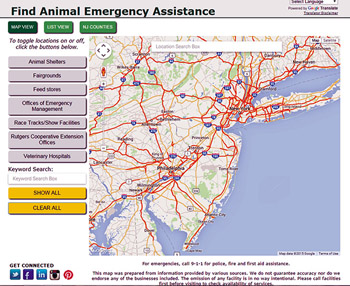Disasters can take many forms, from hurricanes, flooding, electrical storms, high winds, extreme heat/extreme cold, blizzards, tornadoes, wild fires, building fires, etc. During a disaster, unless there is an impending impact to where you and your animals are located, such as in a fire, it is best to stay in a safe location and wait until the storm is over before venturing out.
During a disaster, listen to a battery-powered radio and/or check for alerts on your TV and phone regarding weather and disaster information, along with official instructions and announcements from emergency management and other officials. To sign up to receive critical alerts from your local and county community, check out your town's website and your county's office of emergency management's webpage.
Click here to find your local County Animal Response Team (CART) or local Office of Emergency Management.
Find Animal Emergency Assistance
Use this interactive tool to help find resources for before, during and after disasters in New Jersey. You will be able to locate animal shelters, veterinary hospitals, fairgrounds, feedstores, Offices of Emergency Management, racetracks/show facilities, and Rutgers Cooperative Extension offices. You simply type in your current location or specify any location you're interested in and you will find results.
PETS
Disasters may cause strange sounds, which may frighten your pets to hide in inaccessible places. Keeping your pets in their crates, cages or carriers until the disaster passes, will keep them safe. By keeping them confined, you are also ready to take your pet with you, along with their disaster supply kit, if you are told to evacuate.
LIVESTOCK
Most likely during a disaster it will be necessary to shelter your livestock in a location that gets them out of the storm and/or dangerous areas that could flood or trap your animals with downed trees and electrical wires. It is advisable to also have a back-up plan by having access to other places to hold your livestock or having on hand livestock panels to enclose them, should your shelter or fences be impacted.
Make sure your livestock have stored feed and stored water available, in a readily accessible place and in some cases on higher ground, should your farm areas or roads becomes inaccessible due to debris or flooding. Water in streams and water wells can become contaminated by floods and standing water can become frozen in winter storms. Click here for a disaster feeding/watering schedule for livestock (waterfoodconsumption.pdf)
If your livestock rely on electricity for cooling, milking or watering, make sure your generator is equipped to handle these loads and is ready to go, if the power is out after the disaster. Farm equipment that might be utilized to clean up damage and debris after the disaster, should be kept in a secure and accessible location and be ready (fueled up) to go.
Keep your list of unique animal identifiers (ear tags, hoof paint markings, brands, etc.) for your animals in a secure place, along with the emergency phone numbers of your veterinarian, neighbors that can help, generator fuel supplier, County Extension Agent, County Office Emergency Management, should you need assistance after the disaster.
 Official Site of The State of New Jersey
Official Site of The State of New Jersey